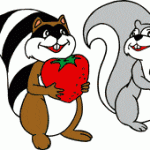Wildlife Need Their Enemies as Well as Their Friends

It was still black dark, early in the morning, the opening day of wild turkey season. I cradled my 20-gauge shotgun and sat there transfixed by the musical gurgle of the current in the stream. From time to time, a breeze would cause the treetops, still bearing their autumn foliage, to break into song, some of the most mesmerizing music I am aware of.
We had no real intention of bagging a wild turkey. Mostly, I think it was the craving to be out in the woods so early in the morning. My fly fishing buddy Al, a kindly soul, even confessed later that he had no intention of shooting a turkey and would have purposely missed if one had shown up.
As the sun peeped over the timbered hills, darkness turned to dawn, then to daylight. About midmorning, I sensed movement in the underbrush across the creek in about the same spot that I had earlier sighted the starlit tree. I watched in amazement as a huge buck deer with a great rack emerged and descended to the stream to drink.
I carefully stepped from my hiding place behind a screen of white pine and hemlock branches. The deer was safe from me. I have never hunted deer. I grew up hunting pheasants and cottontail rabbits, but had no desire to kill a deer. By that point in my life, I really had no desire to kill anything. Our turkey hunting trip was more of a lark than anything else.
I stood there in open view. The deer stared at me. I stared back at the deer. Neither of us said a thing. The deer exhibited no fear of me. I found that odd. At one point, I waved my arms and jumped up and down, thinking to send him on his way bearing a healthy suspicion with regard to my fellow humans. No way. He continued to stare at me with curiosity.
I finally shouted, “Hey, Stupid! My friend,” not Al, but one who did have a passion for hunting deer, “is downstream with a crossbow. Get out of here.”
Finally, my visitor took the hint and went bounding out across the forest in the opposite direction from the man with the crossbow. Later, when the three of us headed back to the cars to lunch at a nearby restaurant, I joked, “Hey. I saw a big buck deer. I sent him down to you. Didn’t you see him?”
That should have been the end of it. I had every reason to believe that it was the end to it. Alas, there are few happy endings in life.
A week later, on a bright Saturday morning, my friend pulled into my driveway announcing triumphantly that he had bagged the deer with his crossbow. The bloodied remains of the once-regal stag lay lifeless in the back of his pickup. I felt as though I had betrayed the friendly deer, wished profoundly that I had never mentioned his presence along that woodland stream. Ever since, I have tried unsuccessfully to convince myself that deer travel over vast distances and that the dead one was not the same one who had befriended me.
And yet, I am aware of the old axiom that nothing in nature dies a natural death. Even though I gave up hunting many years ago as my views evolved to approximate those of St. Francis and John Muir, I do not bash hunters as a group. For countless ages, the hunter was one of the most valued members of the tribe, providing food for otherwise protein-strapped members. Is there any real difference between my friend who killed the deer with his crossbow and the housewife who purchases a pound of ground beef at the supermarket or the traveler who stops by McDonald’s for a quarter pounder? The activities of hunters pale when compared to the horrors of the contemporary factory farm and slaughterhouse. Being a step removed from the process conveys no virtue. Some find it troubling that humans apparently evolved from a species of highly efficient killer apes who learned to turn chunks of flint into powerful tools and weapons, but reality is reality.
It is my habit each morning when the local paper arrives on our doorstep to scan the police and sheriff’s blotter to see what nefarious activities my fellow townsmen have been up to. Most mornings, the county sheriff reports collisions between deer and motor vehicles. This may attest to a healthy population of white-tailed deer, or, depending upon one’s viewpoint, an overpopulation. The Department of Natural Resources in my state reports that there are an estimated 750,000 deer. Farmers complain that there are too many, given deer’s insatiable appetite for corn and other crops. Hunters wish there were more.
Last year in my Midwestern state, hunters took 196,888 deer. It is uncomfortable for many, including myself, to admit that human hunters are necessary to prevent an overpopulation of deer. The argument in favor of licensed deer hunting is that an overpopulation fosters such infections as chronic wasting disease, a fatal neurological disorder for which there is no cure. CWD is a tragic illness that strikes white-tailed deer, mule deer, moose and elk. The symptoms are weight loss and stumbling and listlessness as the infection turns the brain into spongy matter. Wildlife officials in some states refer to the infected as zombie deer because of their lack of coordination and peculiar gait. Deer hunters will argue that their activities prevent such illnesses.
However, lest hunters take themselves too seriously, the predations of the wolf or the cougar actually lead to a healthier deer herd, eliminating the weak, the old, the unaware, leaving the stronger to reproduce. Meanwhile, human hunters often seek the biggest, healthiest buck with the most impressive rack.
Whenever a species, such as an apex predator, is lost, the always precarious balance of nature is disrupted. Even the tiniest creature is a vital link in the ecosystem. Even more so, it would seem, when the creature plays a huge role in the overall health of the entire system. Nature does not permit a void to remain unfilled for long. Take away wolves, and coyotes proliferate. Eliminate mountain lions, and the deer population increases to destructive levels. Lacking the presence of such creatures, taking away human hunters will have the same result.
While the first European explorers were fascinated by the proliferation of wildlife in North America, from day one they were obsessed with eradicating the wolf population. That obsession continues to this day in some parts of the U.S., for instance, Montana, Wyoming and Idaho. Meanwhile, more enlightened and humane citizens labor to restore wolves to their natural habitat in places like Colorado. Nature needs its predators as much as it needs its prey.
In his groundbreaking environmental memoir A Sand County Almanac, Aldo Leopold tells of a time when southwestern ranchers totally eliminated wolves from their neighborhood because some livestock appeared on the lupine dinner menu from time to time. Soon, the deer population burgeoned to such an extent that the vegetation necessary for cattle to graze was stripped from the earth.
Leopold describe it thus, “I have watched the face of many a wolf-less mountain, and seen the south-facing slopes wrinkle with a maze of new deer trails. I have seen every edible bush and seedling browsed, first to anemic desuetude, and then to death. I have seen every edible tree defoliated to the height of a saddle horn.”
We need the big bad wolf, who is not bad at all but merely doing what his wolf genes tell him to do. If human hunters were eliminated, the resulting void would need to be filled by something else; wolves, cougars, grizzly bears. Of course, The Big Bad Wolf’s resurgence would cause wails of anguish as farmers, pigs and housewives’ poodles began to disappear in the night. For a wolf, a meal is a meal, and the easiest item to latch onto is a temptation too good to resist.
Does a deer meet his end more or less painfully from a crossbow bolt or from the jaws of the wolf?
A few years back, while on my evening walk in the woods adjoining Fort Fisher, the Civil War outpost along the Cape Fear River, I came upon a herd of seven deer. I froze, as did the deer, and we stared at one another for long minutes. The fascination seemed to be mutual. After a while, I quietly said, “It is okay for you to stay here and talk to me, but never go near others of my kind. We do terrible things and are not to be trusted.”
- A FATEFUL VOYAGE - March 28, 2024
- Lessons From The TragicLife And Death Of Topsy The Elephant - February 29, 2024
- The Other Churchill - January 30, 2024









